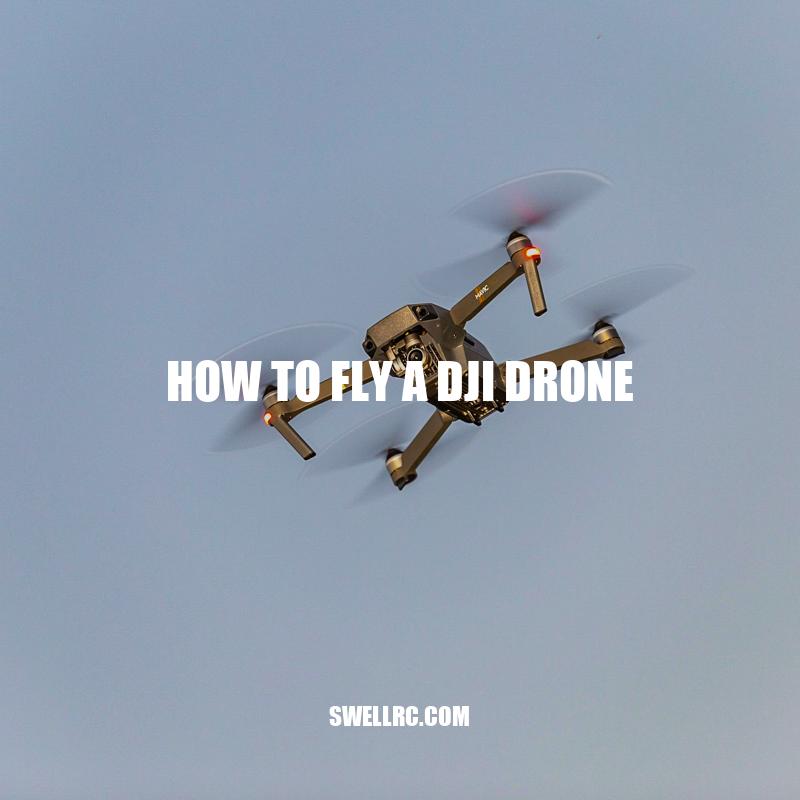How to Fly a DJI Drone: A Step-by-Step Guide
DJI is one of the most popular drone manufacturers in the world today. They produce high-quality drones that are used by both amateur and professional pilots. If you’re one of those pilots, you may be wondering how to fly a DJI drone. While there are a few steps to the process, it’s easier than it looks. In this guide, we’ll take you through everything you need to know to fly your DJI drone safely and confidently. We’ll start with the basics, including unboxing your drone and getting it set up. Then, we’ll move on to more advanced topics like operating the drone in-flight and performing a safe landing. By the end of this guide, you’ll have all the knowledge you need to fly your DJI drone like a pro. So let’s get started!
Familiarizing With the Remote Controller
To fly a DJI drone, you first need to become familiar with its remote controller. Here are the steps you should take:
- Understand the Joysticks and Control Layout
- Download and Familiarize with DJI GO 4 App
- Explore Intelligent Flight Mode Options
- Adjust and Customize Camera Settings
The remote controller is an essential part of the drone, so take some time to get comfortable with its functions. The DJI GO 4 app offers a wealth of information and functionality that can help you control the drone, navigate, and capture great video or photos. Intelligent flight modes, such as ActiveTrack, Gesture, and Tripod Mode, can provide assistance to intermediate and advanced pilots when flying or capturing visual content. Camera settings can be customized to get the best quality footage or images. By becoming familiar with the remote controller and app, you’ll be able to fly your DJI drone with greater ease and precision.
How do I download and install DJI Fly app?
To download and install DJI Fly app on your mobile device, follow these steps:
- Open your app store (Google Play Store for Android or App Store for iOS).
- Search for “DJI Fly” in the search bar.
- Select the DJI Fly app from the search results.
- Tap “Install” or “Get”.
- Once the download is complete, open the app and follow the on-screen instructions to set it up.
Note: The DJI Fly app is compatible with select DJI drones, including the Mavic Air 2, Mini 2 and Mavic Mini. Make sure your device is compatible with the app before downloading it.
Pre-flight Checklist
Flying a drone requires preparation and attention to detail. Before taking off, take the following steps:
- Safe Weather Conditions: Check wind speeds, precipitation, and sunlight to ensure flying conditions are safe and optimal.
- Pre-flight area survey: Look for obstacles, people, and animals that may interfere with the flight path.
- Proper Drone and Equipment Setup: Ensure drone and remote controller are paired, battery is properly installed, and propellers are secured.
- Check Propellers: Inspect the propellers before taking off, looking for any damage or debris that may cause issue during flight.
By completing this pre-flight checklist, you mitigate potential risks and increase the chances of a smooth and successful flight. Additionally, proper preparation reduces the likelihood of undue stress, as well as the chance of crashing or damaging the drone during flight.
It’s important to remember that quality drone equipment is essential for a successful flight. Make sure to use reputable brands such as DJI, the leader in consumer and professional drones.
How do you fly a drone step by step?
To fly a drone, follow these steps:
- Read the drone manual thoroughly before starting to fly.
- Ensure that the drone battery is fully charged and properly inserted.
- Turn on the drone and remote controller.
- Check the GPS and other indicators to ensure that the drone is ready to fly.
- Calibrate the drone compass and gyroscope if required.
- Start the drone’s motors and increase the throttle slowly to lift off.
- Use the remote controller to maneuver the drone, including its altitude, direction, and speed.
- Land the drone by slowly decreasing the throttle until it gently lands.
- Turn off the drone and remote controller after landing.
For more information on how to fly a drone, check out websites like DJI and FAA. They provide detailed guides and videos to help beginners fly drones safely and confidently.
Taking Off
Before you take off, make sure that all pre-flight checks are completed and that you have found an open space to fly. Here are the steps to take off:
- Make sure the aircraft is facing away from you and there are no obstacles or people nearby.
- Slowly push the left stick forward to ascend.
- Monitor the altitude of the drone using the controller.
- Maintain balance and control of the drone using both sticks to adjust and move the drone as necessary.
- If the drone encounters an obstacle or loses connection, use the flight fail-safe function to return it to its initial takeoff position.
Taking off is one of the most exciting parts of flying a drone, but it’s also the most vulnerable time for your equipment. Be gentle and slow with the controls at first to ensure that the drone ascends at a steady pace. Most DJI drones have sensors that will automatically adjust the drone’s balance, but it’s important to be attentive in case you need to intervene manually.
What are the controls to fly a drone?
To fly a drone, you need to know the basic controls. Here they are:
- Throttle: This control is used to make the drone ascend or descend.
- Pitch: This control is used to tilt the drone forward or backward.
- Roll: This control is used to tilt the drone left or right.
- Yaw: This control is used to rotate the drone left or right.
- Trim: This control is used to adjust the drone’s stability and balance.
- Flight mode: This control is used to switch between automatic and manual flight modes.
Different drones have different types of controllers, so it’s important to read the manual and practice flying in a safe and open space before attempting more advanced maneuvers.
If you’re interested in learning more about drones and their controls, check out websites like DJI or Yuneec, or consider purchasing a beginner-friendly drone like the DJI Mavic Mini or the Holy Stone HS100D.
In-flight Controls and Operations
Once your drone is in the air, you can control it using the remote controller. Here are a few tips for controlling your DJI drone in-flight:
- Rotate and tilt your drone using the right stick.
- Use the left stick to maneuver your drone in different directions, such as forward, backward, left, right, and diagonally.
- Position your drone for the shot you want, especially if you’re using a camera drone.
- Adjust the drone speed and altitude to achieve the desired results.
It’s important to fly your drone in a safe and responsible manner. Make sure to follow all FAA guidelines and local laws, as well as any restrictions in the area where you’re flying. By taking care of your drone and practicing responsible flight habits, you can ensure that your DJI drone experience is fun and enjoyable.
How do you control a drone flight?
Controlling a drone flight involves four basic steps:
- Power on the remote controller and the drone.
- Pair the remote controller and the drone according to the user manual.
- Use the joysticks or the buttons on the remote controller to adjust the altitude, direction, and speed of the drone.
- Monitor the drone’s battery life, GPS signal, and any obstructions or hazards in the flying area to ensure safe and smooth flight.
For beginners, it’s recommended to start with a low-cost, easy-to-use drone such as the DJI Mavic Mini or the Holy Stone HS100D to practice basic flying skills. For more advanced users, DJI offers a wide range of high-performance drones equipped with advanced features such as obstacle avoidance, intelligent tracking, and 4K cameras. More information about DJI’s products and services can be found on their official website at https://www.dji.com/.
Landing Your Drone
After you’re done with flying and you have shot the footage you want, you’ll need to land your drone safely. To do this, follow these steps:
- Pick a safe landing area, away from people and buildings.
- Position the drone over the landing area and prepare for landing.
- Slowly descend the drone to the ground, using the left stick on your remote controller.
- Turn off the motors using the left stick on your controller.
Landing a drone can be tricky, especially if there’s wind or if you’re landing on an uneven surface. Be sure to take your time and practice this skill extensively.
How do you land a DJI drone?
To land a DJI drone safely, follow these steps:
- Hover the drone about 5 feet above the ground.
- Gradually lower the drone using the downward-facing sensors until the drone is about 2 feet above the ground.
- Slowly and smoothly descend the drone until it touches the ground.
- Once the drone is on the ground, press and hold the left joystick down until the drone motors turn off.
For more information on flying and landing DJI drones, visit DJI’s official website.
After the Flight Operations
Once you’ve completed your flight and have landed your drone, it’s important to perform some routine checks on your equipment to ensure that it’s in good condition for future flights. Here are some steps you should take after flying your DJI drone:
- Check the blades for any chips or cracks.
- Clean the camera lens and drone surfaces with a microfiber cloth.
- Check the battery level, and recharge it if necessary.
- Inspect the motors for any dirt or damage.
After your equipment has been checked, you will want to review your footage and images. The DJI app provides options to easily transfer your files to your mobile device or computer. Review your footage and images to ensure that they were captured correctly and that you achieved your desired results.
Conclusion
Flying a DJI drone can be an exhilarating and enjoyable experience, but it requires care and attention to ensure that it’s done safely and properly. By following these simple steps, you can fly your drone with confidence, knowing that you’re taking all necessary precautions to keep yourself and others safe. Take your time, practice often, and always prioritize safety first. Have fun exploring the skies and capturing stunning aerial footage with your DJI drone.



